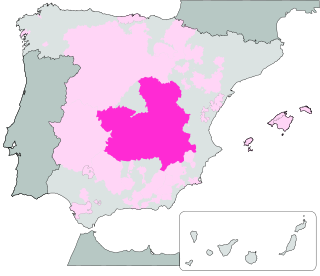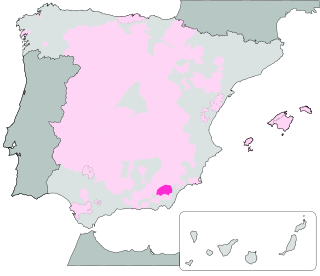Dominio de Valdepusa is a Vino de Pago from Spain. This is the highest category on the quality scale of Spanish wines and means that in addition to having a proven track record of consistent quality, the wines have to be both produced from estate-grown grapes and also have to be processed and aged in a winery (bodega) located on the estate. This Vino de Pago is located in the municipality of Malpica de Tajo, in the province of Toledo and acquired its status in 2003.
Guijoso is a Vino de Pago from Spain. This is the highest category on the quality scale of Spanish wines and means that in addition to having a proven track record of consistent quality, the wines have to be both produced from estate-grown grapes and also have to be processed and aged in a winery (bodega) located on the estate.
Finca Élez is a Vino de Pago from Spain. This is the highest category on the quality scale of Spanish wines and means that in addition to having a proven track record of consistent quality, the wines have to be both produced from estate-grown grapes and also have to be processed and aged in a winery (bodega) located on the estate. This Vino de Pago is located in the municipality of El Bonillo, in the province of Albacete and acquired its status in 2002.
Dehesa del Carrizal is a Vino de Pago from Spain. This is the highest category on the quality scale of Spanish wines and means that in addition to having a proven track record of consistent quality, the wines have to be both produced from estate-grown grapes and also have to be processed and aged in a winery (bodega) located on the estate.

Pago de Arínzano is a wine estate that uses the Vino de Pago wine appellation, a classification for Spanish wine applied to individual vineyards or wine estates, unlike the Denominación de Origen Protegida (DOP) or Denominación de Origen Calificada (DOCa) which is applied to an entire wine region. This Vino de Pago is located in the municipality of Aberin, in the Foral Community of Navarra, Spain, and is geographically within the borders of the Navarra DOP. The 300 hectares estate was purchased by the Chivite family in 1988 and was operated by Bodegas Chivite until it was sold in 2015 to a multinational drinks firm, SPI Group.

Pago de Otazu is a branch of Bodega Otazu, a Spanish winery in Navarre, Spain. The Pago de Otazu branch uses the Vino de Pago wine appellation, a classification for Spanish wine applied to individual vineyards or wine estates, unlike the Denominación de Origen Protegida (DOP) or Denominación de Origen Calificada (DOCa) which is applied to an entire wine region. This Vino de Pago is located in the municipality of Echauri, a village only 8 km from Pamplona, the capital of the Foral Community of Navarra, Spain, and it is geographically within the borders of the Navarra DOP. The winery, Bodega Otazu, also sells wines under the Navarra DOP appellation.

Pago Irache is a branch of Bodegas Irache, a Spanish winery in Navarre, Spain. The Pago Irache branch uses the Vino de Pago wine appellation, a classification for Spanish wine applied to individual vineyards or wine estates, unlike the Denominación de Origen Protegida (DOP) or Denominación de Origen Calificada (DOCa) which is applied to an entire wine region. This Vino de Pago is located in the municipality of Aberin, in the Foral Community of Navarra, Spain, and is geographically within the borders of the Navarra DOP. This Vino de Pago is located in the municipality of Ayegui, near the town of Estella in the Foral Community of Navarra, Spain, and is geographically within the borders of the Navarra DOP. The winery, Bodegas Irache, also sells wines under the Navarra DOP appellation.

Campo de Cartagena is a Spanish geographical indication for Vino de la Tierra wines located in the autonomous Region of Murcia. Vino de la Tierra is one step below the mainstream Denominación de Origen indication on the Spanish wine quality ladder.

Abanilla was a Spanish geographical indication for Vino de la Tierra wines located in the autonomous region of Murcia. Vino de la Tierra is one step below the mainstream Denominación de Origen indication on the Spanish wine quality ladder.
DOP El Terrerazo is a Spanish geographical indication for Vino de Pago wines produced in the estate of El Terrerazo located in the municipality of Utiel, in the province of Valencia in the autonomous community of Valencia, Spain. The sole proprietor of this estate is Bodega MustiguilloArchived 2015-07-03 at the Wayback Machine.

Castilla is a Spanish geographical indication for Vino de la Tierra wines located in the autonomous region of Castilla-La Mancha. Vino de la Tierra is one step below the mainstream Denominación de Origen indication on the Spanish wine quality ladder.

Cádiz is a Spanish appellation describing Vino de la Tierra wines whose terroir is located in the autonomous region of Andalusia. Vino de la Tierra is one step below the mainstream Denominación de Origen indication on the Spanish wine quality ladder.

Sierras de las Estancias y los Filabres is a Spanish geographical indication for Vino de la Tierra wines located in the autonomous region of Andalusia. Vino de la Tierra is one step below the mainstream Denominación de Origen indication on the Spanish wine quality ladder.
Pago Florentino is a Vino de Pago from Spain. This means that in addition to having a proven track record of consistent quality, the wines have to be both produced from estate-grown grapes and also have to be processed and aged in a winery (bodega) located on the estate.
Bodegas Vicente Gandia , is a Valencian wine producer and seller company founded in 1885. Hoya de Cadenas, its family-owned estate, is located in Utiel, Spain. The cellar produces and sells wines from different appellations of Origin including Utiel-Requena, Valencia, Alicante, Rioja, Ribera del Duero, Rías Baixas, Rueda and cava.
Lebrija is a Spanish Denominación de Origen Protegida (DOP), traditionally called a Vino de calidad con Indicación Geográfica. This is one step below the mainstream Denominación de Origen quality wines and one step above the less stringent Vino de la Tierra wines on the quality ladder. It is located in the province of Seville, and as of 2019 includes one winery, Bodegas González Palacios.
IGP Murcia is a Spanish geographical indication for Vino de la Tierra wines located in the autonomous region of Murcia. Vino de la Tierra is one step below the mainstream Denominación de Origen indication on the Spanish wine quality ladder, and mirrors the Vins de pays of French wine. It acquired its Vino de la Tierra status in 2011.










